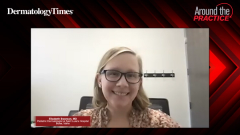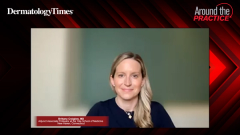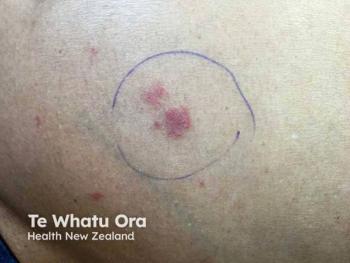
Case 1 Continued: Treatments Beyond Topical Agents and the Use of Dupixent
Joshua Zeichner, MD; Brittany Craiglow, MD; Elizabeth Swanson, MD; Vikash Oza, MD; and Raj Chovatiya, MD, PhD, discuss treatments beyond topical agents and the use of dupilumab in pediatric patients with atopic dermatitis.
Episodes in this series

Joshua Zeichner, MD: What about treatments beyond topicals, especially in our younger patients? What’s your approach to incorporating oral or injectable medications like dupilumab [Dupixent]?
Raj Chovatiya, MD, PhD: That’s a good question. I can take this one, Lisa. It sounds like you had something very pithy to say, but I’ll give it to you in just a second. You touched on the fact that we have a biologic option on label as of not too long ago, where we can use dupilumab all the way down to the age of 6 months, which is incredible to think about it. Because previously for systemic therapy, options were super limited.
The funny thing is that for systemics before dupilumab, no matter the age group, we never had official indications for most of this stuff. Even with methotrexate, which is what probably gets used the most in the pediatric population, a lot of it is anecdotal data and people being used to it rather than actual trial data or an approval. Obviously, that’s on the list, but dupilumab has a far more favorable efficacy and safety profile in that regard. Some of the other more noninvasive modalities aren’t going to work on children. For an adult who’s very phobic of any risk, light therapy is a great choice, but you aren’t getting children to sit still for light therapy, so that isn’t happening either. Your options were always quite limited, based on trying to soup up that topical regimen. It’s an exciting time.
Elizabeth Swanson, MD: Yes, and I’ll add a couple things about the use of dupilumab in younger age groups. Through what might be a computer glitch, I’ve been lucky enough to benefit from the fact that Idaho Medicaid has been covering dupilumab down to the age of 6 months for the past year. That has been exciting for me. I’ve been able to help a lot of children in this age group with their atopic dermatitis. In my opinion, choosing a systemic agent before we had dupilumab was like picking a porta potty out of a row of porta potties. You know [none of them are ideal], but you have to pick one when you have to go. I was never excited to put a patient on methotrexate or cyclosporine. I did it out of desperation. As Brittany said, before dupilumab, I tolerated a higher level of disease because I wasn’t ready to put them on a systemic immunosuppressant.
Treating these younger age groups, the fact that dupilumab is an injection can be a bit of a tough conversation because these are young children, and nobody likes a shot. But I tell my patients and their families that in these younger age groups, the dosing is every 4 weeks. I say, “Dupilumab turns the atopic dermatitis into something that you guys are thinking about once a month, not every single day, 2 or 3 times a day, as you’re applying ointments and sticky creams.” I find that resonates with families as a way to encourage the therapy and open their eyes to the therapy as an option.
Raj Chovatiya, MD, PhD: That idea of adherence is key. Because for all age groups, with anything you have to do every day or twice a day that’s greasy, annoying, and messes up your clothes, you invariably end up getting lax on the therapy. Even our best-laid topical plans probably aren’t followed through. If it’s something that you’re doing once a month, even if it may be uncomfortable for a second or two, it’s way easier to stay on top of it, and 100% adherence is usually going to mean better results in the long run.
Brittany Craiglow, MD: I have a quick point. I have been surprised. One would think that the conversation with a family starting a very young child would be harder than with an older child, but I have found that in many cases, it’s easier. That’s because the parents haven’t gotten to that point where they think, “This is just the way life is.” They’re still desperate to find a treatment for their child. They’re still waking up every night and thinking, “This isn’t OK. This isn’t the way my toddler should be,” vs the 10-year-old who has never known anything different. It’s easy to think it’s going to be a lot harder, but some of these families are ready. The discussion goes well and you can make a big difference.
It’s interesting to consider whether we’re potentially going to change the natural history of the disease or interfere with the atopic march. In treating these younger children, there are so many things in the future that we’re going to be able to look back on and see.
Elizabeth Swanson, MD: The parents of a 2-year-old with bad atopic dermatitis are very tired, sleep-deprived, and desperate for something to make it better.
Vikash Oza, MD: I have one little counterpoint. When we’re talking about infants and children under the age of 2, it’s also worthwhile to note that the number of infants on the clinical trial was quite low, fewer than 10 children. In terms of evaluating safety aspects, our long term is based on a small number of patients in the clinical trial. That’s still important to keep in mind. It becomes a lot easier for us to reach for these biologics for frustrated families or people who aren’t getting relief because we’re comfortable with them, but we have to have strong considerations when we’re putting a child under the age of 1 on a systemic medication.
There are other issues that come up too. Live vaccines aren’t to be given on biologics, at least at this point, and their MMR [measles, mumps, rubella] and varicella vaccines are done at 1 year. There are other challenges that come up. But at the same time, most children who have severe eczema under the age of 1 may not have severe eczema at the age of 5. It may not be the same longitudinal course that we adopt when you have a 12-year-old with severe eczema. This may be more of a temporary thing. There are also a lot of exciting things in terms of the impact on the march that Brittany referred to. We don’t have data for that yet, but it’s going to be interesting when we follow these children through.
Brittany Craiglow, MD: That’s a great point, and it’s important to note that it’s going to be very unusual that an infant needs systemic therapy. People unfortunately are uncomfortable treating very young children with aggressive topicals. But for a lot of these children who come in and look terrible, if you treat them appropriately and give them their pound jar of hydrocortisone 2.5% or triamcinolone, and you get them to clear, you can maintain a lot of those children fairly well. As Vikash said, just because we have dupilumab doesn’t mean we should forget our mainstay of therapy, which is still going to be useful for a good number of patients. But for those who we can’t get—I think it’s going to be more that 2-to-5 age group—we have this other option.
Vikash Oza, MD: Because a severe 8-month-old doesn’t turn around quickly. We were just talking about education. The biggest thing for any person is, when do you schedule your follow-up visit? You have to reinforce a lot of education. The foundation of care is to have short-term follow-up after your first visit. If it’s a severe patient, have that visit 2 to 3 weeks later if you can squeeze them in. Because a lot of times, you notice a gradual improvement months down the road for an infant with severe eczema.
I agree with Brittany regarding leaping toward Dupixent in a 7-month-old right off the bat. You have to think about the severity and all our pediatric dermatology things. Is there a genetic driver of this? Is there an underlying immunodeficiency that we could be looking at when you’re talking about using a systemic agent on a 7-month-old?
Transcript edited for clarity
Newsletter
Like what you’re reading? Subscribe to Dermatology Times for weekly updates on therapies, innovations, and real-world practice tips.
























